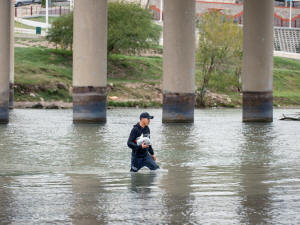COVID border restrictions on migrants to stay after U.S. Supreme Court
order
 Send a link to a friend
Send a link to a friend
[December 20, 2022]
By Ted Hesson, Steve Holland and Jose Luis Gonzalez
WASHINGTON/CIUDAD JUAREZ, Mexico (Reuters) -The U.S. Supreme Court on
Monday said COVID-era restrictions at the U.S.-Mexico border that have
prevented hundreds of thousands of migrants from seeking asylum should
be kept in place for now, siding with Republicans who brought a legal
challenge.
The restrictions, known as Title 42, were implemented under Republican
former President Donald Trump in March 2020 at the beginning of the
COVID-19 pandemic and gave border officials the ability to rapidly expel
migrants to Mexico without a chance to seek U.S. asylum.
U.S. President Joe Biden, a Democrat, had campaigned on overturning
Trump's hardline immigration measures before taking office in 2021 but
kept Title 42 in place for more than a year. The U.S. Centers for
Disease Control and Prevention (CDC) said this year that Title 42 was no
longer needed for public health reasons, and the Biden administration
has said it wants it to end but will abide with any court rulings.
A federal judge last month ruled Title 42 was unlawful in response to a
lawsuit originally brought by asylum-seeking migrants represented by the
American Civil Liberties Union. The judge set the restrictions to be
lifted on Wednesday, Dec. 21.
But a group of 19 states with Republican attorneys general sought to
overturn that decision by intervening in the case and on Monday took
their request to the conservative-leaning Supreme Court.
Hours later, Chief Justice John Roberts in a brief order issued a stay
that will leave Title 42 in place until further notice from the court.
The parties in the legal dispute have until Tuesday at 5 p.m. ET (2200
GMT) to respond, the court said.
After Robert's action, U.S. Department of Homeland Security (DHS) said
Title 42 "will remain in effect at this time and individuals who attempt
to enter the United States unlawfully will continue to be expelled to
Mexico."
The Biden administration had been preparing for Title 42 to end on
Wednesday and press secretary Karine Jean-Pierre said on Monday that the
White House was seeking more than $3 billion from Congress to pay for
additional personnel, technology, migrant holding facilities and
transportation at the U.S.-Mexico border.
The push for additional resources came as U.S. authorities had been
preparing for the possibility of 9,000 to 14,000 people per day trying
to cross into the United States if Title 42 was lifted, Reuters and
other outlets have reported, around double the current rate.
The Biden administration has been weighing plans to prepare for Title
42's end, with government officials privately discussing several
Trump-style plans to deter people from crossing, including barring
single adults seeking asylum at the U.S.-Mexico border.
[to top of second column]
|

A migrant crosses the Rio Grande from
Mexico into Texas as U.S. border cities are bracing for an influx of
asylum seekers when COVID-19-era Title 42 migration restrictions are
set to end, in Eagle Pass, Texas, U.S. December 19, 2022.
REUTERS/Jordan Vonderhaar
DHS last week updated a six-pillar plan that calls for the expanded
use of a fast-track deportation process if Title 42 is terminated.
The revised DHS plan also suggests there could be expansion of legal
pathways for migrants to enter the country from abroad, similar to a
program launched for Venezuelans in October.
BORDER CITIES OVERWHELMED
Since Biden took office in January 2021, about half of the record 4
million migrants encountered at the U.S.-Mexico border have been
expelled under Title 42 while the other half have been allowed into
the United States to pursue their immigration cases.
Mexico accepts the return of only certain nationalities, including
some Central Americans and, more recently, Venezuelans.
For months, El Paso, Texas, has been receiving large groups of
asylum-seeking migrants, including many Nicaraguans who cannot be
expelled to Mexico. On Saturday, the city's mayor declared a state
of emergency to move migrants from city streets as temperatures had
dropped below freezing.
U.S. Representative Henry Cuellar, a Democrat whose South Texas
district borders Mexico, has said U.S. border officials told him
that an estimated 50,000 people are waiting in Mexico for the chance
to cross.
"If Title 42 remains in place, we must continue waiting," said
Venezuelan migrant Lina Jaouhari, who said she had attempted to
enter the United States from Ciudad Juarez on Dec. 1 but had been
sent back to Mexico under Title 42. "It won't do any good to try to
cross again if we know they will send us back."
In El Paso, shelters have struggled to provide for arriving migrants
even as many ultimately are headed to join relatives in other parts
of the United States.
Rescue Mission of El Paso, a shelter near the border, last week
housed 280 people, far beyond its 190-person capacity, with people
sleeping on cots and air mattresses in the chapel, library and
conference rooms, said Nicole Reulet, the shelter's marketing
director, in an interview with Reuters.
"We have people where we tell them, 'We have no room,'" she said.
"They beg for a place on the floor."
(Reporting by Ted Hesson in Washington and Jose Luis Gonzalez in
Ciudad Juarez; Additional reporting by Jackie Botts in Oaxaca City,
Richard Cowan in Washington and Lizbeth Diaz in Tijuana and by Nate
Raymond in Boston; Editing by Stephen Coates and Bradley Perrett)
[© 2022 Thomson Reuters. All rights
reserved.]
This material may not be published,
broadcast, rewritten or redistributed.
Thompson Reuters is solely responsible for this content. |